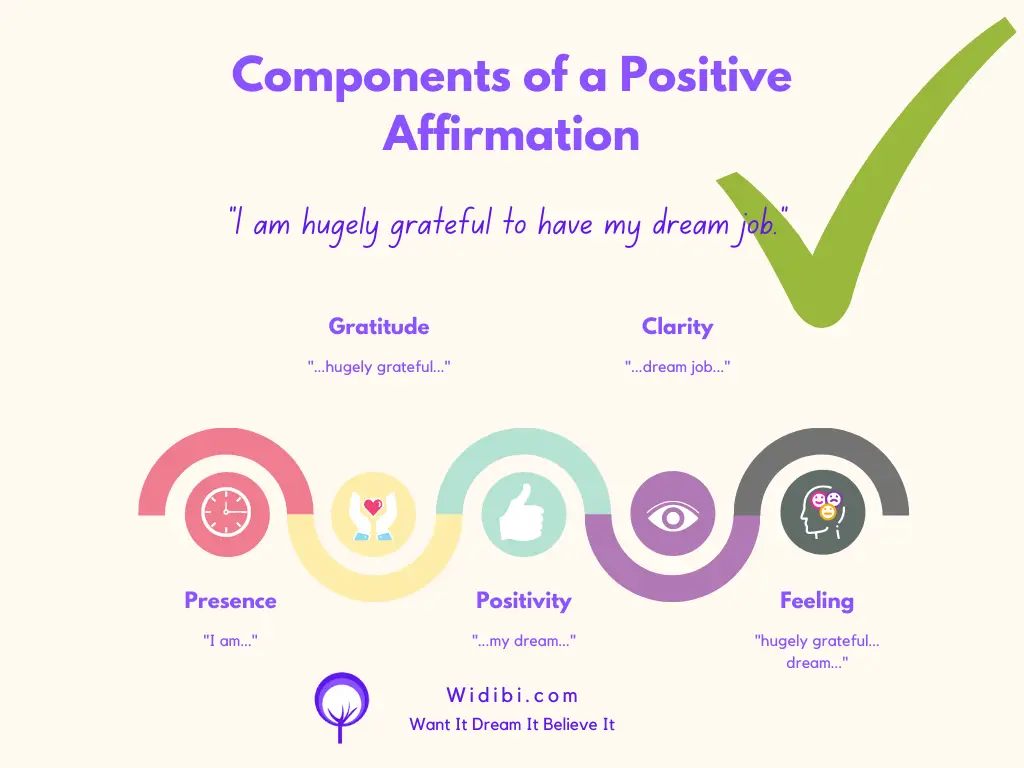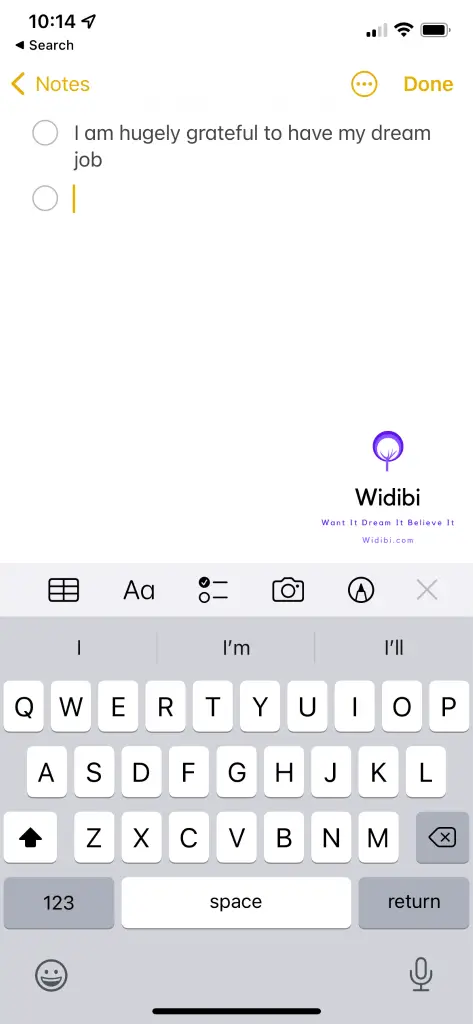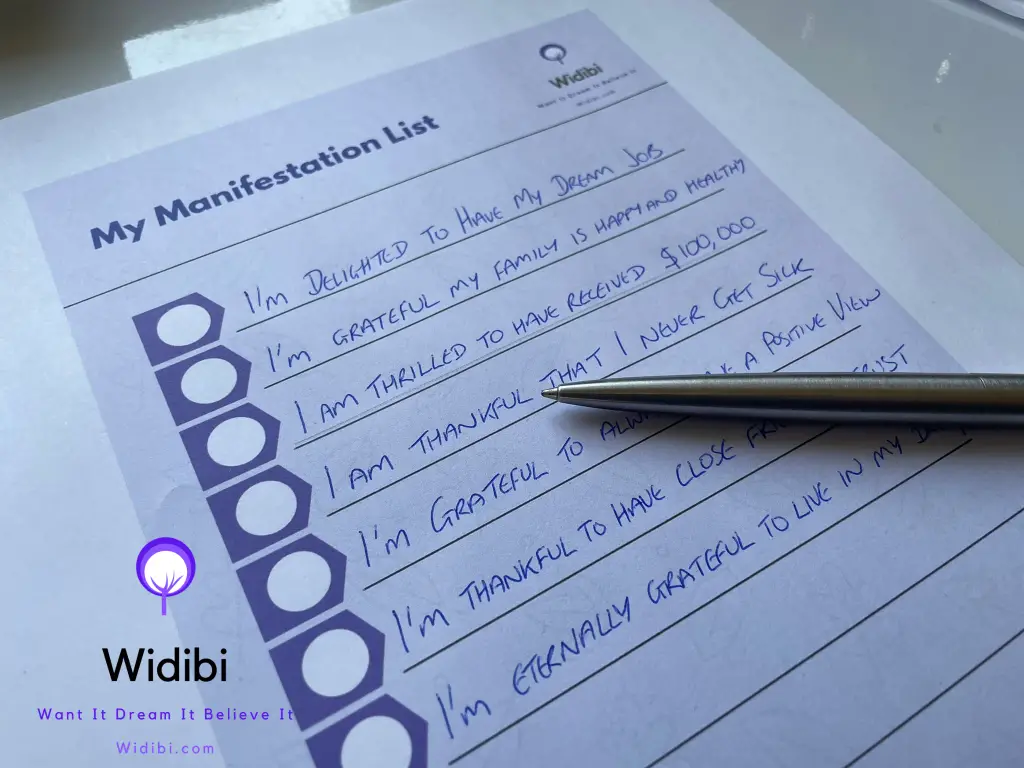A rotating affirmation list does exactly what it says on the tin – it’s a rotating list of affirmations that are there when you need them, provide structure when you want to motivate yourself, invoke the law of attraction or manifest something, but have the flexibility to add or remove things however you see fit.
The rotating affirmation list is a manifestation technique of sorts and one I designed myself. It shares similarities with many other methods – it could easily be compared with another manifestation option I created myself, the instant vision board.
Why I Created the Rotating Affirmation List
I recently wrote something of an opinion piece here at Widibi entitled Keeping the Law of Attraction Relevant in the 21st Century. It touches on the fact that the law, along with affirmations, manifestation, and all sorts of other aspects of the practice, has been around for centuries. They also come in and out of public consciousness. I consider The Secret as being the most recent mainstream and perhaps even definitive book on the law of attraction, but it’s certainly not the first. However, it might be the last.
Fortunately, the law of attraction as a practice isn’t going anywhere anytime soon. There are hundreds of websites devoted to it and thousands of articles covering anything and everything. It’s also extremely popular on what could be considered the definitive technology of today in social media. Say what you will about the positives and negatives of social media as a concept, but it’s where a lot of people across generations consume much of their content.
You won’t have to search too hard for video, audio, and text across the most popular platforms covering manifestation techniques, writing affirmations, and much more. Technology has, to a point, embraced the law of attraction and everything that goes with it. Unfortunately, however, not all practitioners have embraced technology.
And then there’s me, Oli. I love technology. While I can’t rival Bill Gates’ Xanadu 2.0 or the $65 million it took to build it right now, me of 15 years ago would be amazed at how much of my home I can control from my phone or iPad.
Yet I still see articles advising people on how to use the law of attraction. Take writing affirmations. At worst, I see people recommending – in articles written in the last couple of years, no less – only to write affirmations with a pencil on paper.
It only gets slightly better when people ask questions like, “can I type affirmations?” A decent outcome usually involves the writer stating something along the lines of “you can, but you shouldn’t.” They’ll then qualify this statement with things like “it’s less powerful if you write affirmations digitally.”
That’s where I start to disagree. It’s also where I start coming up with digital alternatives to tried and tested methods:
- I have a physical vision board on the wall. I have a dozen digital ones across computers and tablets.
- I haven’t touched a physical manifestation journal in years. My manifestation journal today is a Word document.
- I’ll write manifestation lists by hand, but I can just as easily do it on my phone and often do.
Crucially, I only write about things with which I have experience. I’ve been into the law of attraction and affirmations since before the internet was a thing. Admittedly, I’ve always had a computer during this time, but I’ve done the hard yards when it comes to physical affirmations and scripting.
Overcoming Doubt in the Law of Attraction
Favoring technology isn’t the only way in which my law of attraction opinions potentially differ from my peers. I’m also open to criticism, argument, and sheer disbelief. I know because I’ve seen first-hand that the law of attraction is easy to doubt and dismiss as a concept. Likewise, I fully accept that it’s one of those things that is impossible to prove to someone else.
If I told you the law of attraction was real, you might believe me. The majority wouldn’t. Meanwhile, I’m sitting here with absolutely no convincing proof. Evidence extends no further than me saying it does, and perhaps referring to a few people you might have heard of that would say the same.
The proof is in the pudding. One of the reasons I encourage people to use the law of attraction so much is because it’s something that can prove highly beneficial while being easily dismissed. You don’t know it works until it works for you. And you’ll never find out if it works until you try.
No matter how positive the results can be, it’s never easy to get someone to leave their comfort zone for the first time. I can already see the doubts in a newbie’s thinking:
- “It’s a waste of time.”
- “What if something bad happens?”
- “What if it doesn’t work?”
And that’s just the polite ones.
To get someone to try it, you need to make it easy. You’re not going to encourage someone to create their first vision board by telling them they need to head to the craft store and spend $100. The cheaper you can make something, the easier it is to get someone to try it.
Likewise, you don’t want to waste their time. For whatever reason, the law of attraction may not work for them. It could be a lack of commitment or belief. It might be writing affirmations wrong. There are definitely points of failure in manifesting and affirmations, which is one of the reasons why I cover it so extensively.
So how do I do this? With the rotating affirmation list.
How to Make a Rotating Affirmation List
I designed the rotating affirmation list for myself. I wanted something quick, easy, and readily available.
To make yours, you’ll need three things:
- A goal or dream
- A smartphone
- A notes app
If you’ve got a smartphone, you’ve probably already got a notes app. I use the one on my iPhone that literally came installed. If not, grab something like OneNote or Evernote, both of which I also highly recommend. Apple Notes is enough for an affirmation list, but you might want to plan out your goals, dreams, and perhaps even your entire life once you get into a rhythm, so added features are always welcome!
With your hardware and dream in place, you then need to write an affirmation. A strong affirmation looks something like this:

Using the above example, you now have a rotating affirmation list that looks a little something like this:

Crucially, and just to repeat, you now have a rotating affirmation list. That note saves automatically, so you’ve already made what you set out to.
The law of attraction is all about abundance, and there’s nothing wrong with multiple affirmations, and yes, you can manifest more than one thing at a time. Affirmation lists are unlimited. The only potential limitation is the storage space on your device or in the cloud.
And just to reassure you, affirmations written on a phone are just as powerful as those written in a dedicated, physical manifestation journal with the most delicate calligraphy.
The Difference Between a Manifestation List and a Rotating Affirmation List
Manifestation lists and affirmation lists are inherently very similar. Both list out affirmations, usually with a specific goal in mind. There are two key differences:
Manifestation Lists are for… Manifesting
Manifestation lists involve a specific kind of affirmation whereby you want to make something happen in your life. It’s often more concerned with material gains than emotions. For example, “I am happy” is an affirmation. However, it probably won’t appear on a manifestation list unless you particularly need to go out of your way to manifest happiness.
It’s far more likely to find “I am hugely grateful and thrilled to have moved into my dream house.” That’s how you might manifest the mansion you’ve got your eye on.
The dream house can appear on your affirmation list, too, by all means. Still, you probably won’t put emotional affirmations such as love, happiness, and motivation that you need on specific days on a manifestation list.
A Manifestation List is More Permanent
Even I, a defender of technology’s role in the law of attraction, like to write out manifestation lists by hand. They don’t change all that often. Here’s an example from our manifestation list article:

It’s on paper, and it’s written in pen. It wasn’t created with an eye on upcoming changes. As I mentioned in that article, there’s nothing at all wrong with crossing something off or adding another row at the bottom. After all, if you’re trying to manifest something and it happens, you don’t need to keep on actively affirming it so that it won’t disappear!
Rotating affirmation lists are digital specifically because it’s easy to add, remove and modify affirmations. They could be short-term affirmations, even down to a specific day. Once they’ve succeeded, you no longer need them and can focus elsewhere by holding down the backspace key for a second or two.
What to Put on Your Affirmation List
Affirmations that land on your affirmation list should be:
- Short to medium term
- Created using the five pillars of successful affirmations
- Both for manifestation and feeling
There is, of course, nothing to stop you from maintaining both an affirmation list and a manifestation list. I certainly do. The former is for daily check-ins – something to affirm when I find myself with a spare few minutes. The latter is more longer-term, almost like a vision board with just words that I keep stuck on the wall.
Creating both is a great idea. Not only do they separate your instant affirmations and longer-term goals, but they can also feed each other. For example, suppose my phone affirmations are a bit thin on the ground. In that case, I can pluck something from my manifestation list to add, giving it more focus and potentially making it faster and more potent in the process.
Conversely, if something on my affirmation list becomes less of a priority and more a long-term goal, it can rotate out and join the manifestation list instead.
For example, your career goal might be to become a department head. You want it, and you want it as quickly as possible, so you put it on your rotating affirmation list. However, you’re offered a sideways promotion for more money before that comes to pass. You’d still like to reach department head status, but you’re happy with the job offer in the meantime. Department head becomes a longer-term, less pressing goal. It rotates off your affirmation list, but you don’t want to let go of it entirely, so you add it to your manifestation list.
Short-Term Focus
The rotating affirmation list is specifically designed to add and remove affirmations, sometimes every day. It often includes goals you can reach quickly and effectively or affirmations that only apply to a specific event.
“I’m grateful to have excelled in the sales presentation” is something that might pop up on your affirmation list on Tuesday when you have the presentation on Thursday. Then, when you’ve sealed the deal straight after the presentation, you fire up your notes app, pat yourself on the back, and swipe it away.
Even less specific affirmations work. I always seem to return to the “I am motivated” example. It’s an affirmation, so it qualifies. However, it doesn’t refer to anything specific other than getting you in the right headspace. You don’t need to feel motivated every day (I assume). Sometimes, baseline you is more than enough to win the day. However, days will come along when you need to up your game in specific ways:
- If you’re nervous about something coming up on the day, “I am confident.”
- If you’re worried about the outcome of something that lies ahead, “I’m grateful that I can always do a fantastic job.”
- If you need to remember to pay a bill, “I’m hugely thankful always to have the cash I need to stay on top of bills.”
Add what you want (but don’t refer directly to wanting it as that can stop it happening), and then, once it’s done, get rid, make space, and add something else.
At the start of a week, I might have ten affirmations on my rotating list. By the end of the week, I might still have ten. However, I won’t have more. They won’t be exactly the same either.
I might be down to just one or two. However, I like to look ahead at the week on a Sunday evening. That’s when the rotating affirmation list fills back up again.
Using Your Affirmation List
There are plenty of structured methods of using the law of attraction out there. The manifestation journals, 5×55 method, and vision boards mentioned above all bring cohesion to the practice. I appreciate structure and use all these tools.
An affirmation list is deliberately flexible. When you have the solid foundations of vision boards and journals, you can work towards creativity and experimentation. That’s another way in which affirmation lists put a modern spin on the law of attraction. Attention spans are generally shorter. People want quicker gratification.
Simple manifestations are easier to achieve than more complex ones. The universe rearranges your reality to make manifestations happen. The more it has to do, the longer it takes.
My most common example of instant gratification in manifesting is parking spaces. The universe is so in tune with my desire to park close to the entrance wherever I go that I don’t even need to ask anymore. I got the idea from the late Barbel Mohr, who focuses more on cosmic ordering than the law of attraction, but they’re closely intertwined.
I don’t need to add parking spaces to any kind of affirmation list. However, it illustrates how to differentiate between smaller and heftier goals. An empty space in a parking lot won’t change the world, but it makes my life a little easier. Plus, once I find the space, it’s done and checked off.
I also happen to have a house on my manifestation list (and vision board). I’ve been pretty specific about what I want, although it’s not a particular home that I know exists. It wouldn’t suit an affirmation list. It’s big, expensive and probably includes technology that hasn’t been invented yet. But I know I want it, and I’m sure the universe is working on making it a reality for me. However, there are so many steps between my present and that future that I know it’ll take a while.
If you’re trying affirmations lists for the first time, or you’re unsure about the law of attraction, start small. If you try to manifest a massive house when you currently live in a studio apartment, I can all but guarantee that you’ll have given up on manifesting as a concept before you even come close to moving in.
In doing so, you’ll never have that lightbulb moment – the one that has you thinking, “Wow, this stuff really works!”
Start with the kind of thing that would suit a rotating affirmation list perfectly, and go from there. When it works once, you know it can work again, and that kind of confidence is integral to manifesting both quickly and effectively.
Your Rotating Affirmation List – In Summary
Affirmations don’t have to be long-term, and manifestation doesn’t need to take forever either. So while having dreams that you have no idea how to make come true and goals that will take years is a great idea, that’s no reason not to shape the present.
The positive, grateful nature of affirmations means they can be helpful in a wide variety of situations, whether you just need to perk yourself up or you’ve got big ambitions for the week ahead. The rotating affirmation list helps by focusing on what matters right now, and it’s always available because it lives in your phone.
The concept brings together technology and affirmations for positive changes that will reinforce your ability to achieve what you want to. The best part is that you can get started immediately!










